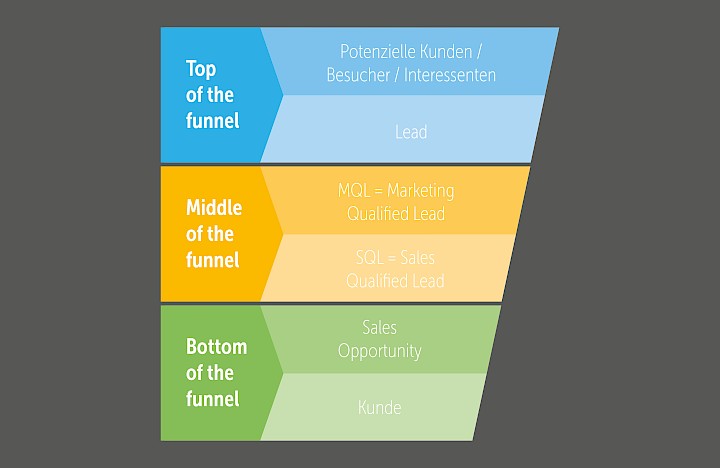Lead generation
The term lead generation comes from marketing and refers to the process and the associated measures for acquiring prospective customers. The aim is to increase sales for the company. For this reason, the generation of leads is of great importance in the sales department of many companies. As lead generation can take place in all communication spectrums, the size of the company does not initially play a role in the generation of leads. It is also irrelevant whether your company is active in B2C (business to consumer) or B2B (business to business). Lead generation is not limited to individual methods or strategies. Rather, it comprises different approaches and techniques that can be categorized according to the media used, production control (push and pull principles) or the focus on quantity or quality. These are summarized as lead management.
In lead generation today, as in many other areas, we are seeing technological progress. In the past, lead generation mainly consisted of buying lists of names and cold calling.
Lead generation - What are leads actually?
In order to gain a better understanding of the topic of lead generation, the definition of "leads" needs to be explained in more detail.
The term "lead" comes from the English language and has numerous meanings - e.g. indication, lead or guidance. In marketing, leads are people who have already shown an interest in a company's products or services but have not yet made a purchase decision. A lead therefore refers to a potential new customer who has signaled a willingness to buy but has not yet taken action.
When acquiring prospective customers, companies try to create incentives, attract attention and generate the interest of potential new customers by taking various measures. The aim is for interested parties to provide their data voluntarily. New customers can be acquired, for example, by registering on the landing page or by filling out a contact form. The user provides their contact details to the company in return for an offer, an e-book or a checklist, for example. It is up to the company to decide how to make contact.
BANT - You can use these criteria to define "leads" for your company
It makes sense for every company to first define the term "lead" internally. Develop criteria that characterize a lead for your company. Leads should be relevant to your sales target. You can use the BANT method, for example:- Budget: What budget does the prospect have available
- Authority: Does the interested party have decision-making authority ?
- Need: Is there a need in his company?
- Time: In what time frame should the investment take place?
Basics for lead determination
The determination of a lead is related to the strategic direction of a marketing campaign. In order to develop a clear, industry- and company-specific marketing strategy and to save resources for the company, marketers should clarify the following questions before launching the lead generation marketing campaign
.- Quantity or quality: Generate a mass of leads (e.g. traffic) or only specific leads (e.g. sales-qualified leads)?
- Medium/network: Through which channels (e.g. email marketing, social media, blog) does the company receive the targeted leads?
- Push or pull: How is the campaign set up and implemented?
What is lead generation? - Leads in the sales funnel
Lead generation takes place in each of the three stages of the sales funnel (describes the steps of the sales process). These stages are typically:
- Awareness (upper part of the funnel or Top of the Funnel): The prospect becomes aware of his problem or need. They start looking for solutions. In doing so, they come across relevant products or services. Consideration (middle part of the funnel or middle of the funnel): The prospective customer analyzes and evaluates these products or services and contacts the providers.
- Decision (bottom of the funnel or bottom of the funnel): The potential buyer makes a decision that solves their problem and meets their requirements.
You should focus on content that offers your leads added value at every stage of the buying process when generating leads. In the beginning, you should attract attention without directly urging them to buy. Content such as e-books, checklists and white papers that are relevant and informative for your users are particularly suitable for lead generation in this phase. Most consumers nowadays do their research online before making a purchase. Your content should therefore support users in solving problems in advance. If you attract the attention of potential leads during this information phase, they are more likely to decide to purchase your product or service.
When companies convert prospects into leads, they draw them into the funnel. In the top of the funnel (at the beginning of the customer journey), for example, a request for a quote or filling out the contact form is referred to as a lead. In the middle of the funnel, marketing differentiates between generating Marketing Qualified Leads (MQL) and Sales Qualified Leads (SQL).Marketing Qualified Lead (MQL)
MQLs are people who have already come into contact with your marketing and have shown a positive response. They are in the phase in which interest in your company has been signaled. They would like to receive more information about your offer by contacting you directly. However, please note that this does not necessarily have to result in an intention to buy and ultimately a purchase.
In the digital world, a popular method for generating MQLs is to offer information that is valuable to the target group in exchange for contact details. Examples include a checklist, a whitepaper, downloading software trials or free e-books on the landing page.
Marketing Qualified Leads are converted to SQLs when people are even more interested in your offer after receiving more engaging information.
Sales Qualified Lead (SQL)
Sales Qualified Leads, abbreviated as SQLs, are what every sales representative is most happy about. These are people who have signaled their interest in your offer several times through interaction with your marketing. These leads have already been pre-qualified and can be passed on to sales so that they can, for example, conduct a sales conversation and complete the purchase process.
We also refer to people who directly book or initiate a sales call as SQLs and thus strongly communicate their intention to buy. These valuable leads do not go through your marketing department first, but as they go straight to the sales call without any detours, the categorization as SQLs is justified here.

Types of lead generation
The classic approach to lead generation is known as dialog marketing. Marketing measures are taken to establish contact with interested parties and to receive a response from them. The response can take the form of a purchase, for example, with which the customer also discloses their contact details for further use. The strategy has evolved to the present day and marketers can use other types of lead generation.
Basically, lead generation can be divided into offline and online generation.
Offline lead generation:
- Trade fairs or promotional stands - Trade fair appearances offer a good opportunity to generate leads. You have the opportunity to have an unfiltered and personal conversation with visitors. If they turn out to be interested and relevant, they can even be classified directly as SQL in the best case scenario. Phone calls - inbound (incoming) and outbound (outgoing). Legal regulations on cold calling must be observed for outbound calls!
- Network events - Similar to a trade fair appearance, you also have the opportunity to have a personal conversation with potential leads at meetings of your network or other cooperation events.
Of course, events such as seminars or conferences can also contribute to networking. Personal contacts with interested parties are more suitable than if these leads first have to go through the entire process of qualifying a sales funnel. Print - Advertisements in magazines, discount coupons, direct mail, magazines and catalogs, even flyers are typical tools for offline lead generation. However, these can be perceived as annoying by the addressee and therefore have a negative effect.
Digital or online lead generation:
- Website - a typical way in which good leads can be generated is via provided relevant information on your homepage or on special landing pages. This can be, for example, the download of a software trial version of an eBook, a white paper or a checklist. These are "exchanged" for contact information. Be sure to consider data protection when requesting data. There is also the possibility that the more data that is requested, the fewer people could register on the form. You should not ignore these points and keep forms short and concise.
- Landing pages, blogs or online magazines, search engine optimization (SEO) - With appealing content marketing and search engine optimization, you can increase a high, target group-specific reach. In this way, you promote lead generation. However, this only works if you know your prospects and potential future customers, their online behavior and their problems and wishes. Only then can you create the right content for your visitors' customer journey. If you keep these points in mind when creating and optimizing content, you can create coherent content for the reader with little effort. This content should be comprehensible, sensibly linked and hyperlinked.
- Email marketing - Sending newsletters is also one of the typical methods for generating leads. It should be noted that negative effects on the company image cannot be ruled out if users receive newsletters for which they did not originally sign up directly. Express consent must be given by the customer in order to generate a data record. A double opt-in procedure is common here - i.e. a double declaration of consent to receive advertising.
- Social media presence - LinkedIn and Xing are primarily used for lead generation in the B2B sector. Other social networks are more suitable for B2C communication (e.g. Instagram or Facebook).
B2B lead generation via LinkedIn works either by directly addressing the target persons via direct messages, in which case, however, these are cold leads, or via paid lead ads (lead gen forms). Lead ads on LinkedIn are advertisements where people can enter their contact details directly into LinkedIn, usually in exchange for specific content. The advantage of this is that the target group does not have to leave the platform and then possibly jump off again on your website - lead generation is smoother, so to speak. - Advertisements on search engines (SEA), search engine marketing (SEM), paid ads - are among the most important and successful channels for lead generation in the marketing process. If you advertise on Google, for example, you can reach the target groups and potential leads relevant to your company with your message. Clicking on the ad usually takes the user to the company's website, which ideally contains a contact form. The primary goal of many Google Ads campaigns is lead generation. With Google as the world's most widely used search engine and the partner network, you get an enormous reach. With the help of analysis tools, you can access real-time evaluations of your campaigns at any time. This also simplifies the networking of relevant online marketing channels.
Incentives are created for many types of lead generation. These are intended to motivate potentially interested parties to start a purchase process. These can be special offers, discounts or free test products, for example.
Online vs. offline lead generation
Digital lead generation has the technical advantage that the leads are already available in the form of data records after generation. This is much more time-consuming in the offline world, whereas lead generation via online media proves to be more effective and practical.
The coronavirus pandemic in particular has forced companies to rethink their lead generation. Online methods have become established. No trade fairs or events took place during the lockdown and sales work was partially paralyzed. This meant that lead generation also had to be reoriented.
Cold leads
A cold lead is the contact details of a person who is unfamiliar with your company and your offer. This is also referred to as cold calling. Legal regulations must be observed for this type of lead generation (Act against Unfair Competition (UWG), Section 7 Unreasonable Harassment).
Since cold leads require the most persuasion, they are not exactly popular for sales. A comparison can be drawn with the countless spam emails that are sent out every day. Companies acquire a long list of cold leads to send their emails to. The senders hope that enough readers will accept their message and be convinced by the offer.
Cold leads do not necessarily have to be of low quality. When approaching these contacts, you must bear in mind that they may have little or no idea of your existence. You must therefore first develop, sort and qualify the cold leads in order to carry out a sales pitch.
Lead generation and data protection
With some types of lead generation, you need to consider legal aspects. Data protection is a high priority when generating and processing leads. When it comes to personal data of interested parties or potential customers, the GDPR must be taken into consideration. Companies and authorities as well as private individuals and lawyers are particularly sensitized to this topic. When it comes to lead generation, data protection is therefore a major and important issue that you need to address.
Under the GDPR, you are obliged to provide full transparency about the stored personal data at any time upon request. This also applies to the origin and use of the data. Therefore, pay attention to which data you request from interested parties.
Data protection is not only so important because of the GDPR, it also ensures that your target group has confidence in your company. After all, the more secure prospective customers feel with you, the more willing they are to disclose their contact information. Your high level of commitment to data protection therefore has a positive effect on your lead generation.
A typical example of data protection is the inclusion of an opt-out option when registering for a newsletter. An opt-in button is mandatory when passing on data in a web form. The customer must expressly give their consent. Otherwise, no data record may be generated by the company. A common solution for this is a double opt-in procedure.
Goals of lead generation
The aim of lead generation is not just to generate a lead in the form of a data record, as is the case with a competition, for example. The actual goal is to acquire new customers who are specifically interested in your product or service and have the intention to buy. Ideally, such users are relevant prospects who are very likely to become new customers and can contribute to an increase in sales. They have a differentiated motivation and don't just want to win something. If we look at lead generation in detail, there are different milestones. The main goal, which stands above all other intermediate goals, is to achieve an increase in sales.
Creating awareness
Lead generation is now also used to raise awareness and interest in the specific company among the target group. Lead generation methods are increasingly being used to optimize the results of brand awareness practices, for example.
Insights from inbound lead generation (e.g. incoming calls) can help to produce more relevant and convincing content in order to generate awareness. Outbound lead generation, or outbound generation, is therefore an opportunity to consolidate this awareness among the desired target group in a direct and targeted manner.
Optimization of offer, processes & co.
Modern lead generation is characterized by encouraging promising leads to engage with a brand, company, product or service through a personalized approach and constant exchange. This is why marketing measures such as the generation of qualified leads make it possible to do more than simply collect data. Rather, companies can gain helpful insights from customer feedback, which can be used to optimize the conversion rate, product development, sales and customer service, for example.
Acquiring new customers
B2B companies and brands with a range of high-priced products use sites with contact forms to generate a list of potential customers. Providing free information on the company website in return for contact information can be beneficial here. In e-commerce, these pages can also be used for generating customer lists and planned email marketing.
Lead generation is still seen as a single stage of the customer journey through the sales funnel. However, the use of lead generation measures is much more flexible and wide-ranging than the initial definition suggests.
Lead generation in today's digital world
In the past, the everyday life of sales employees was characterized by making contact with potential customers and presenting their products or services to them. This is how lead generation used to be practiced.In today's digital age, we have been observing a change for years: the internet is omnipresent and everyone has easy access to information. Customers have the opportunity to inform themselves comprehensively on the web. Search engines, social media, blogs and other online channels are available around the clock. This means that consumers can research products or services without having to contact the sales department of the respective company.
On the other hand, companies are also benefiting from this development. Nowadays, entrepreneurs can get an overview of potential customers and their environment with little effort. Regardless of whether they are active in the B2B or B2C sector. If you know the wishes and requirements of your own target group, you can win them over with targeted information. In addition, factors such as demographic data can help to identify new leads.Users who are still at the very beginning of the customer journey need to be picked up by companies. First, you need to grab their attention. After all, your goal is to draw them deeper into the sales funnel and convert them into leads. In an advertising context, landing pages are often an integral part of lead generation campaigns. With content created by your marketing team or an SEO agency optimized for search engines, your page is displayed in the results list for relevant search queries. With an existing online presence, search engine optimization can lead to sustainably better leads and therefore effective lead generation.If a page is created with the aim of generating leads, it is usually designed to collect data. This is why they almost always contain a contact form.In today's world, companies must not only strive to acquire new customers, but also to build close relationships with leads and nurture them.
Effective lead generation through teamwork between marketing and sales
The developments in the purchasing process described above also have an impact on the tasks of sales and marketing. While the two disciplines used to have clearly separate areas of work, nowadays lead generation is more of a joint challenge. Marketing is taking on an increasingly important role and is no longer limited to providing and handing over a lead list to sales.
Nowadays, lead generation requires sales and marketing employees to work hand in hand. Combined as lead management, the teams jointly decide which leads should be approached and maintain close relationships with these customers. Marketing uses demographic data when qualifying and evaluating leads and takes customer behavior into account. In the next step, marketing employees ensure that the promising leads are forwarded to sales.Once a lead has been qualified by sales, the decision to purchase is almost certain. However, the future customer may still have questions or needs. Sales must address these. The relationship created by Marketing is nurtured by Sales in this phase. These leads are upgraded by both marketing and sales. It is highly likely that they will make a quick decision to purchase.In summary, close collaboration between marketing and sales can lead to more effective lead generation and a higher conversion rate.What is lead generation - Conclusion
Lead generation is the generation of prospective customers and includes various marketing measures. Lead generation aims to obtain contact details from users and send them an offer, a checklist or an e-book, for example, in exchange. Ideally, these contacts will be interested in your offer and ready to buy. With highly qualified leads, you can influence the purchase decision and steer it in the direction of your company and your offer. The overriding goal is to increase sales. Lead generation used to be achieved through sales letters and cold calling. In the digital age, there are numerous online methods for lead generation (in compliance with legal and data protection regulations), for every size of company and every sector. Nevertheless, offline models are still used for lead generation - e.g. trade fairs, flyers or telephone calls. Today, we observe a symbiosis between sales and marketing when it comes to lead qualification and lead relationship management.








